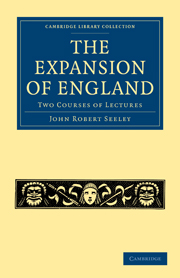Book contents
LECTURE III - HOW WE CONQUERED INDIA
Published online by Cambridge University Press: 05 August 2011
Summary
The question how we conquered India does not at all resemble the questions which I raised in the last course. Our colonists in the new world occupied to be sure a vast territory, but it was comparatively an empty territory. The difficulties they encountered arose not so much from the natives, as from the rivalry of other European nations. By what degrees and from what causes we gained the advantage over these rivals, I partly discussed. It was a question to which the answer was not at once obvious, but at the same time not extremely difficult to find. On the other hand it is at first sight extremely perplexing to understand how we could conquer India. Here the population was dense, and its civilisation, though descending along a different stream of tradition, was as real and ancient as our own. We have learnt from many instances in European history to think it almost impossible really to conquer an intelligent people wholly alien in language and religion from its invaders. The whole power of Spain could not in eighty years conquer the Dutch provinces with their petty population. The Swiss could not be conquered in old time, nor the Greeks the other day. Nay, at the very time when we made the first steps in the conquest of India, we showed ourselves wholly unable to reduce to obedience three millions of our own race in America, who had thrown off their allegiance to the English Crown.
- Type
- Chapter
- Information
- The Expansion of EnglandTwo Courses of Lectures, pp. 197 - 216Publisher: Cambridge University PressPrint publication year: 2010

